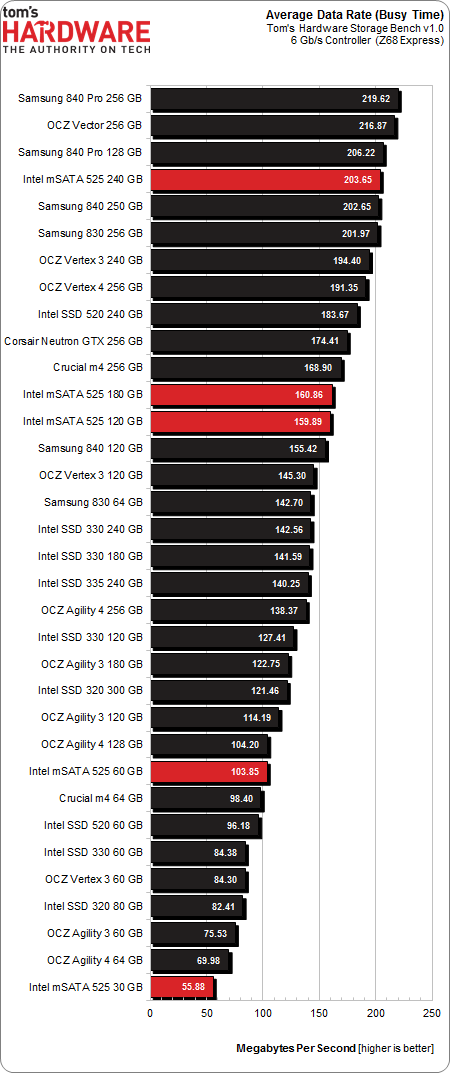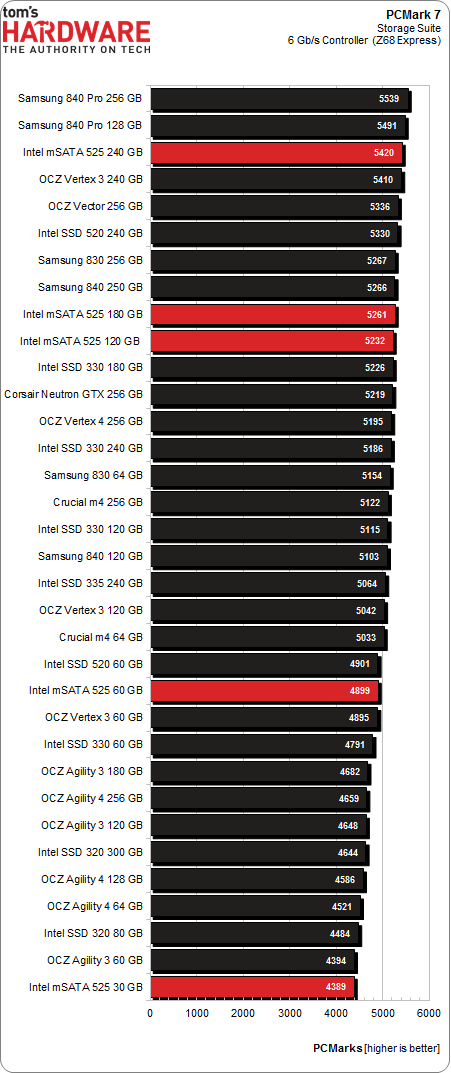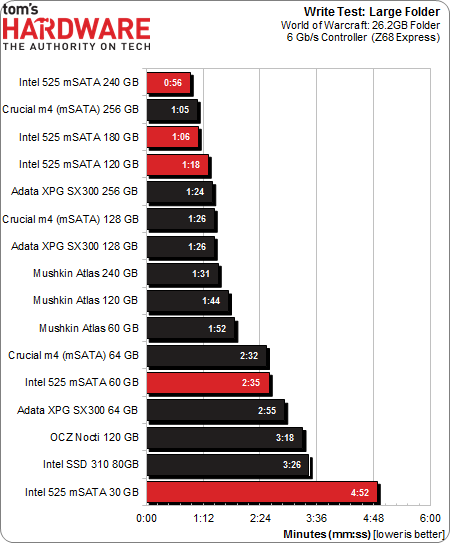Intel SSD 525 Review: Five mSATA Drives, From 30 To 240 GB
Intel has a new family of mSATA-based SSDs powered by SandForce's second-gen controller. Dubbed the SSD 525, we have all five capacities in our lab. Can the promise of strong performance, 5,000 P/E cycles, and a five-year warranty make up for high prices?
Results: Storage Suite v1.0, PCMark 7, And Write Testing
Why you can trust Tom's Hardware
Storage Bench v1.0 (Background Info)
Our Storage Bench trace incorporates all of the I/O from a trace recorded over two weeks. The process of replaying this sequence to capture performance results in numbers that aren't really intuitive at first glance. Idle time gets expunged, leaving only the time that each benchmarked drive was actually busy working on host commands. So, by taking the ratio of that busy time and the the amount of data exchanged during the trace, we arrive at an average data rate (in MB/s) metric we can use to compare drives.
It's not quite a perfect system. The original trace captures the TRIM command in transit, but since the trace is played on a drive sans filesystem, TRIM wouldn't work even if it were sent during the trace replay (which, sadly, it isn't). Still, trace testing is a great way to capture periods of actual storage activity, a great companion to synthetic testing like Iometer.
The 240 GB SSD 525 packs an even bigger punch than the older SSD 520, busting out an excellent 20 MB/s improvement over its Cherryville cohort. This increase effectively comes down to the LLKi-revision firmware, since the two Intel SSDs are otherwise mostly identical. Revamping the garbage collection routines for better steady-state performance pays dividends, since the amount of data written by our trace is enough to put most solid-state solutions into a lower performance state.
The 120 and 180 GB SSD 525s almost manage top-tier performance, but fall just short of the most elite contenders. The only sub-200 GB drive able to beat the middle-capacity SSDs is Samsung's 128 GB 840 Pro. In all fairness, though, it's also faster than the 240 GB SSD 525.
The smallest members of Intel's Lincoln Crest family give us some good and some bad news.
First, the 60 GB model is about as fast in our trace as the 120/128 GB competition equipped with asynchronous NAND. We'd be happier about that news, except that you pay as much for Intel's solution as those larger drives. It's worth considering that Intel has a big price premium on its entry-level mSATA storage.
Not surprisingly, the 30 GB SSD 525 come in last place. Considering its capacity, that's where we'd expect it. However, the drive is absolutely hammered by this trace, which consists of too much data to be fair to a 30 GB repository. The miniature SSD 525 could be a decent cache drive, all things considered.
PCMark 7
PCMark 7 uses the same trace technology as our Storage Bench v1.0 for its storage suite testing. It employs a geometric mean scoring system to generate a composite, so we end up with PCMarks instead of a megabytes per second. One-thousand points separate the top and bottom, but that encompasses a far larger difference than the score alone indicates.
Overall, the rankings don't change all that much between our Storage Bench v1.0 and Futuremark's PCMark 7. The 120 and 180 GB SSD 525s continue to stick together, though they're closer to the top this time. The 60 GB model slides in next to the 60/64 GB competition, and the 30 GB model still lands in last. Intel's 240 GB flagship picks up three slots on the comparably-sized SSD 520, putting it in third place. The 840 Pro is just too brutally fast, overcoming SandForce's reliance on compression to take the top two spots.
Of course, we know that the delta is interesting from an academic perspective, though it'd be almost impossible to tell any of the top 15 drives apart in daily use.
Write Testing
Performing a real-world write test helps illustrate some of the advantages attributable to parallelism and real-time data compression. We're using a folder copy of World of Warcraft. The 26.2 GB collection of files and folders includes a mix of data entropy levels. Archiving the entire hierarchy results in a compression ratio of 63%, meaning that the resulting ZIP file is 63% as large as the original folder. The game data and internal media are already compressed in various ways, making those bits a challenge for SandForce-driven drives, but other parts are easier to shrink. It's a great example of something you might actually copy, or a reasonable enough facsimile.
The 30 GB SSD 525 struggles, requiring an achingly-long 4:52 to finish up. That's 92 seconds more than the second-to-last Intel SSD 310. The 60 GB model takes about half as long, and is three seconds off of the 64 GB m4. The 120 and 180 GB SSD 525s do really well, putting them between Adata's 256 GB SX300 and Crucial's 256 GB m4. Lastly, the flagship SSD 525 beats the big m4 by another 15%, putting it at the top of the class. The most spacious SSD 525 has the advantage of faster compressible write speed than the competition, bolstered by the fact that it doesn't have to write as much data to flash.
Current page: Results: Storage Suite v1.0, PCMark 7, And Write Testing
Prev Page Results: Comparative 128 KB Seqential Performance Next Page Power ConsumptionGet Tom's Hardware's best news and in-depth reviews, straight to your inbox.
-
hero1 Nice article. I would like to see more motherboard makers finding a way to include the mSATA slots right on the board like Gigabyte does. I think the ability to have your OS and programs on mSATA and leave the other SSD for games and storage is very welcome. This will be my next hunt, too bad I got rid of my UD5H because it had mSATA slot. I would like to see such feature in the X99/X89 platform.Reply -
slomo4sho The 250 GB Samsung 840 still seems to be the best buy when evaluating price per performance as it is frequently offered at around $.60 or less per GB.Reply -
abbadon_34 damn site changes, no edit.Reply
Interesting, if some benches weren't Intel only, but all included the relavent competitors. -
dthx damianrobertjonesIt is REALLY unfair to reduce the performance of smaller GB drives!This is not something manufacturers do to just to p*ss off users who buy the smaller capacities.Reply
A small drive has fewer memory chips than a large drive. The controller has then fewer chips to efficiently spread the data to... and this leads to decreased performances. There's nothing immoral to that.
It's not the same story like for example, a couple of years ago, Yamaha selling a 2x CD writer and a 4x CD writer at double the price ... and by removing one resistance, your 2x writer became a 4x model ;-) -
mapesdhs slomo4shoThe 250 GB Samsung 840 still seems to be the best buy whenReply
evaluating price per performance as it is frequently offered at around $.60 or less per GB.
It's a surprisingly good drive, and performs very well on boards that only have SATA2.
I recently upgraded my brother's P55 system with an 840 250GB; the main game he
plays atm now loads in just a few seconds, instead of the more than 3 minutes it took
with the old mechanical disk (and that wasn't exactly a low-end drive either - a WD VR
150GB 10K SATA). He is, as one might expect, very happy indeed.
In addition, I bought him an internal Startech storage unit that holds 4 x 2.5" devices
(it takes up one 5.25" bay) and a couple of 2.5" drives (1TB for general data, 2nd-hand
250GB for backup of the 840). He bought another 1TB for backup, so the Startech now
holds the 840, two 1TB and the 250GB. The end results looks rather good, and the
performance with the 840 is excellent (I bought one for my 3930K setup).
I have a lot of OCZ drives (more than 40, various models); what impresses me the most
about the 840 is the way it maintains top performance even after being hammered with
an 80GB full clone from an old disk, lots of Windows and driver updates, game installs, etc.
Testing with HDTach, AS-SSD, etc. show performance almost identical to an original clean
state. None of my OCZ drives behave this way - the HDTach graph shows significant
variance, while the 840 graph is smooth across the range. Beats me how Samsung has
achieved this, but I like it.
Modern SSDs may be saturating the SATA3 interface, but they bring an amazing new lease
of life to older SATA2 systems.
Ian.
-
ddpruitt The vast majority of mSATA systems use the SSD as a cache, and then it's only Intel systems. I would like to see the mSATA ports be more flexible and offered on a larger variety of systems. I'd love to upgrade the mSATA on my laptop but there's no point, I already use an SSD for the main drive. Turning an mSATA into a usable drive on the system is a PITA and just not worth it.Reply -
Onus I have an Asus Maximus Gene V which has a mSATA slot on a little riser card. I am using a 238GB-usable Crucial M4 there as my system drive. It's been working well, so I have no complaints.Reply
I have an ASRock Z77E-ITX back from RMA that I haven't yet put back into service that has a mSATA slot on its underside. It can be used to build a very small system. That these slots are only 3Gb/s hardly matters when comparing them to the speed of a mechanical HDD.


